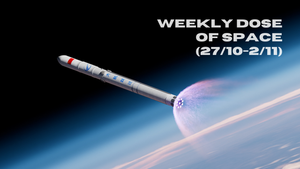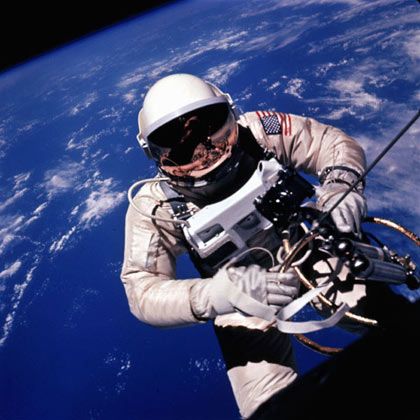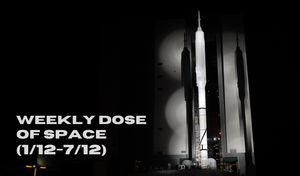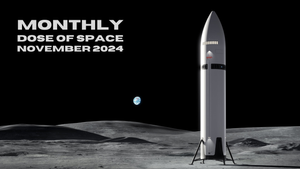
Weekly Dose of Space (27/10-2/11)
Welcome back to Weekly Dose of Space! This week had four orbital launches occur, with one crewed launch. News this week had New Glenn heading to Launch Complex 36, two commercial cargo contracts being awarded, and Impulse Space making progress on Helios. As always, we'll also look ahead to what the worldwide launch schedule might look like next week.
SpaceX
This week at Starbase began on October 27th when Booster 12 was moved outside from the 'mega-bay' and arrived in the 'rocket garden' at the production site on October 28th. The same day the 'chopsticks' on the launch tower were seen undergoing movement testing near the highest point they can move to.
On October 29th, Ship 33 underwent cryogenic propellant loading tests, partially loading both its liquid methane and liquid oxygen tanks with propellant. The next day, the 30th, Ship 33 performed another cryogenic propellant loading test, filling its tanks with liquid methane and liquid oxygen tanks propellant. October 31st had Ship 33 perform another cryogenic propellant loading test. SpaceX hasn't shared how it's testing Ship 33, the first 'Block 2' Starship, but they may be performing more thorough tests to see how some possible major changes handle certain vehicle states.
After all this testing, Ship 33 returned from the Massey's test site to the production site overnight between November 1st and 2nd, possibly to receive six Raptor engines ahead of a static fire.
Launches This Week
October 29th - Long March 2F/G with Shenzhou-19
Taikonauts Cai Xuzhe (蔡旭哲), Wang Haoze (王浩泽), and Song Lingdong (宋令东) blasted off from Launch Area 4 at the Jiuquan Satellite Launch Center atop of a Long March 2F/G for the Shenzhou-19 mission to the Tiangong Space Station. Details about this mission can be found here.

October 30th - Falcon 9 with Starlink Group 9-9
A Falcon 9 lifted off from Space Launch Complex 4E carrying twenty Starlink satellites to low Earth orbit. The booster for this mission was B1075, flying for the fourteenth time and landing on the drone ship 'Of Course I Still Love You' downrange.

October 30th - Falcon 9 with Starlink Group 10-13
From Space Launch Complex 40, another Falcon 9 carried twenty-three Starlink satellites to low Earth orbit. Supporting this mission was booster B1078, making its fourteenth flight and landing downrange on the drone ship 'A Shortfall Of Gravitas'.

October 31st - Soyuz 2.1a with Cosmos 2579
A Soyuz 2.1a lifted off from the Plesetsk Cosmodrome carrying the secretive Cosmos 2579 satellite. Cosmos 2579 is believed to be a Bars-M electro-optical imaging satellite with a resolution of approximately one meter.
In Other Space News
Impulse Space receives first Helios dome

On October 31st, Impulse Space revealed that they have received the first tank dome of its Helios high-energy kick-stage. The Helios kick-stage plans to burn 13,500 kilograms of liquid methane and liquid oxygen in the company's in-house developed Deneb engine to generate 6.8 tons of thrust.
Impulse Space states that three tank domes will be needed to make up the Helios kick-stage along with an outer tank barrel section. The three domes and barrel will be laser-welded together to make up the stage, one dome will also serve as a common bulkhead between the two propellant tanks.
Helios' first flight is currently planned for 2026. The kick-stage can deliver up to 4,500 kilograms directly into geostationary orbit, 7,500 kilograms to a trans-lunar trajectory, and more to many other destinations.
New Glenn's first-stage arrives at LC-36

On October 30th, Blue Origin rolled out the first stage of their New Glenn launch vehicle, transferring the rocket stage from the assembly building to the launch and integration facility at Launch Complex 36 in Cape Canaveral, Florida.
According to Blue Origin's Chief Executive Officer, Dave Limp, transporting the first-stage took multiple hours due to the 23-mile route needed for safe transportation. Moving the first-stage was what Blue has nicknamed GERT, Giant Enormous Rocket Truck, a repurposed U.S. Army Oshkosh M1070 tank transporter. During transportation, the first-stage was secured by a 'strongback assembly' resting on two connected trailers.
With New Glenn's first-stage now at Launch Complex 36, Blue Origin is expecting to conduct a static fire of the stage, with both flight stages integrated for launch. Following a successful static fire, New Glenn's first flight is expected to occur in November.
CMSA awards cargo contracts
Ahead of the Shenzhou-19 launch, the China Manned Space Agency revealed its two choices to develop new cargo transportation spacecraft to help serve operations onboard the Tiangong Space Station. The two companies chosen were the Chengdu Aircraft Design and Research Institute and the Innovation Academy for Microsatellites of the Chinese Academy of Sciences.
The Chengdu Aircraft Design and Research Institute's proposed spacecraft is the Haolong (昊龙) cargo spaceplane. Haolong's design has the wings in a fixed position throughout the flight with its solar panels and radiators protected by two deployable ‘doors’, a cargo capacity was not shared.
The Innovation Academy for Microsatellites of the Chinese Academy of Sciences proposed design is the Qingzhou (轻舟) spacecraft. Qingzhou is a more traditional cargo delivery spacecraft design, being most similar to Northrop Grumman’s Cygnus spacecraft. A cargo capacity was shared with the spacecraft carrying 2,750 kilograms to the Tiangong Space Station and 2,900 kilograms for disposal in the atmosphere.
Both spacecraft are expected to fly in the coming years, no specific timeline was given but a Qingzhou prototype may fly in late 2025. More updates from the China Manned Space Agency shared recently are available here.
What to Expect Next Week
Starbase
SpaceX has yet to reveal when it will targeting launch the next test flight of Starship-Super Heavy. The license for the previous flight does allow for another test flight, so long as no major alterations are made to the flight plan. Ship 31 and Super Heavy Booster 13 have already performed static fire and propellant loading tests. The final major hardware milestones ahead of the next flight are believed to be combined testing of the two vehicles and installation of flight termination explosives.
November 3rd - Falcon 9 with Starlink Group 6-77
SpaceX is expecting to launch a batch of Starlink satellites to low Earth orbit from Space Launch Complex 40.
November 4th - H3 with DSN-3
Japan's H3 launch vehicle is expected to launch the DSN-3 satellite to geostationary transfer orbit from the Tanegashima Space Center. This satellite will be used for Japanese military communications.
November 4th - Soyuz 2.1b with Ionosfera-M 1 & 2
A Soyuz 2.1b is expected to fly to a sun-synchronous orbit carrying two Ionosfera-M satellites. The Ionosfera-M satellites are part of a small constellation for ionospheric and magnetospheric research.
November 5th - Falcon 9 with CRS-31
SpaceX's 31st resupply mission is expected to launch atop of a Falcon 9 from Launch Complex 39A in early November. The booster for this mission is unknown but it is expected to land back at Cape Canaveral.
November 5th - Falcon 9 with Starlink Group 9-10
A Falcon 9 is expected to carry a batch of Starlink satellites to low Earth orbit from Space Launch Complex 4E.
November 5th - Electron for 'Changes in Latitudes, Changes In Attitudes'
Rocket Lab is expected to launch an Electron rocket into a sun-synchronous orbit from Launch Complex 1B, located on the Māhia Peninsula. The customer and payload for this mission have not been stated.




